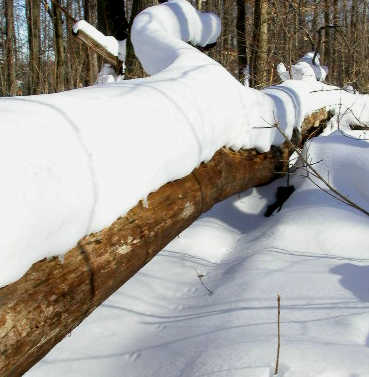
Mice travel under a fallen tree because it is easier and the hawks can't dive in for dinner.

A study by Firman E. Baer of Rutger’s University compared the mineral content of organically-grown foods with non-organically grown foods. The study showed significant differences in the mineral content of these foods. Organically grown snap beans had over 22 times more iron than their commercial counterpart, while organically grown spinach provided 80 times more iron than the non-organic variety. Organically grown food has at least twice as much mineral content in many cases.If that doesn’t convince the skeptics they can send their own samples to be tested.
….a 1992 USDA report estimated the following potential health benefits if everyone in the United States could be convinced to eat a diet containing the recommended daily amounts of primary nutrients shown in the table:So while big businesses may have the money to persuade people that there is no difference in their food homesteaders know and understand the difference because they live closer to the earth and reality - not profits.
20 percent reduction in cancer
25 percent reduction in heart and vascular conditions
50 percent reduction in arthritis
20 percent reduction in respiratory and infectious diseases
50 percent reduction in infant and maternal deaths
“Super-efficient (“Net-zero”) solar homes are now available that reduce monthly energy bills 50 percent to 70 percent compared to comparable conventional homes. Today, anyone can have a zero-energy home by paying, upfront, roughly 10 percent to 20 percent more than the cost of a traditional home for renewable-energy technology, which generally has a payback in energy bill savings of about 20 to 30 years.”You might want to consider an efficient, money saving, new home like the ones mentioned above before rising energy prices get out of hand.
“Net-zero-energy means the homes are super-efficient, with much of their electricity produced by rooftop solar panels; they draw electricity from the grid at night or on cloudy days, but overall they generate at least as much energy as they consume each year.”
“Jeff Christian, director of the Oak Ridge National Laboratory’s Buildings Technology Center, has been studying energy efficiency in homes for more than 30 years, and he wants to make zero-energy homes affordable for everyone. To do so, he needs real-life data from homeowners so his team can refine and improve the homes’ engineering and cost efficiencies. To that end, he hopes to organize a mass purchase of these types of houses: “If we can get a few thousand people who will all order houses at the same time — not all with the same size and floor plan, but the same efficiency principles and materials applied to each, it would add some economies of scale and help us bring the unit cost down,” Christian says. “From a research standpoint, it would be immensely valuable to get the feedback about what works and what doesn’t work from homeowners who really care about these issues.”
If you would like to learn more, send an e-mail to Jeff Christian.